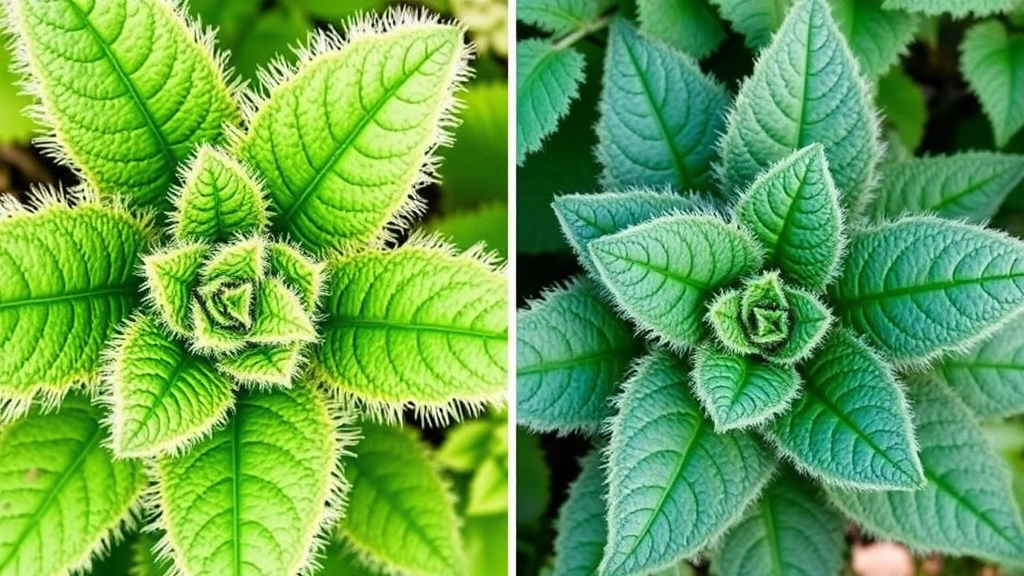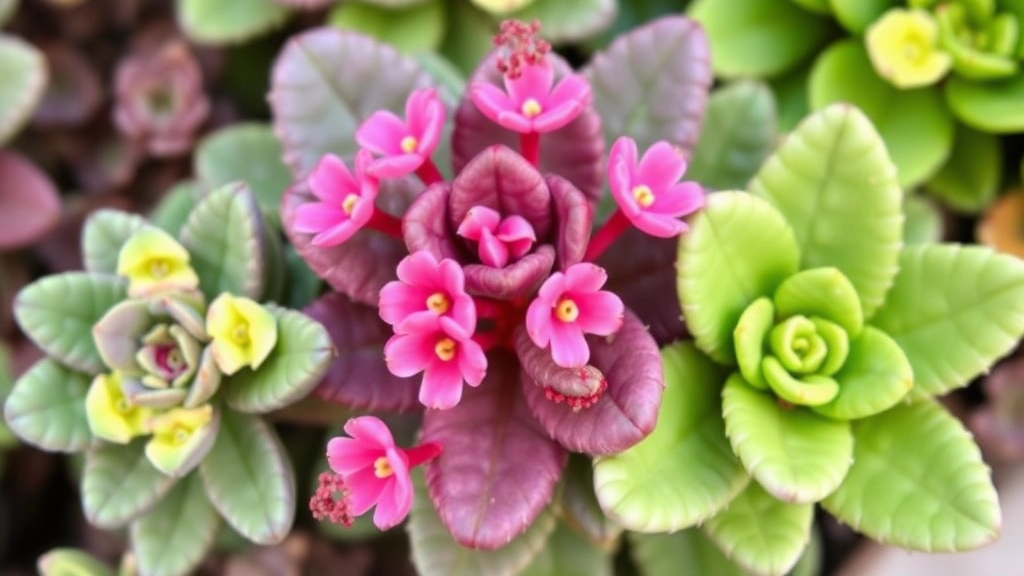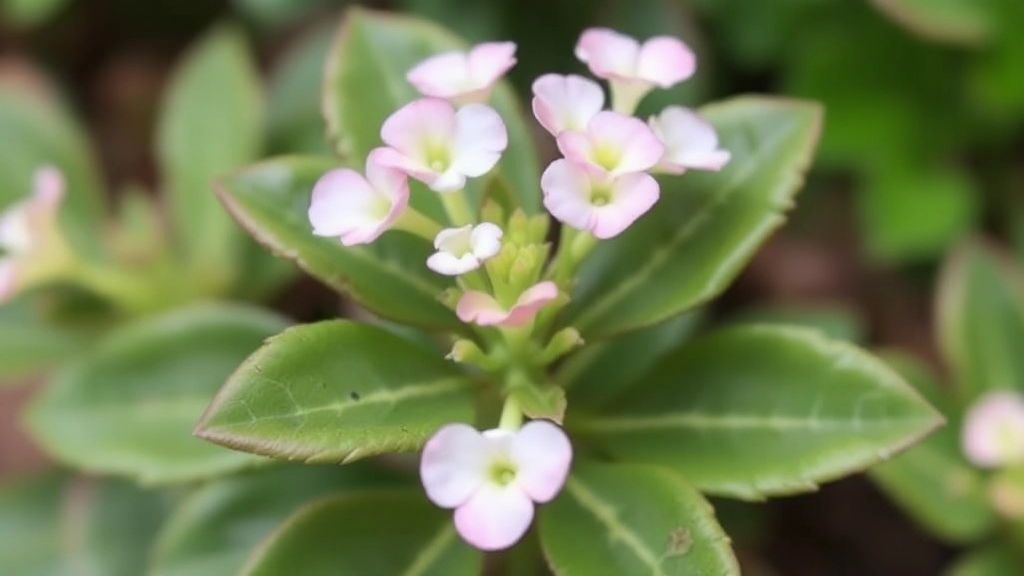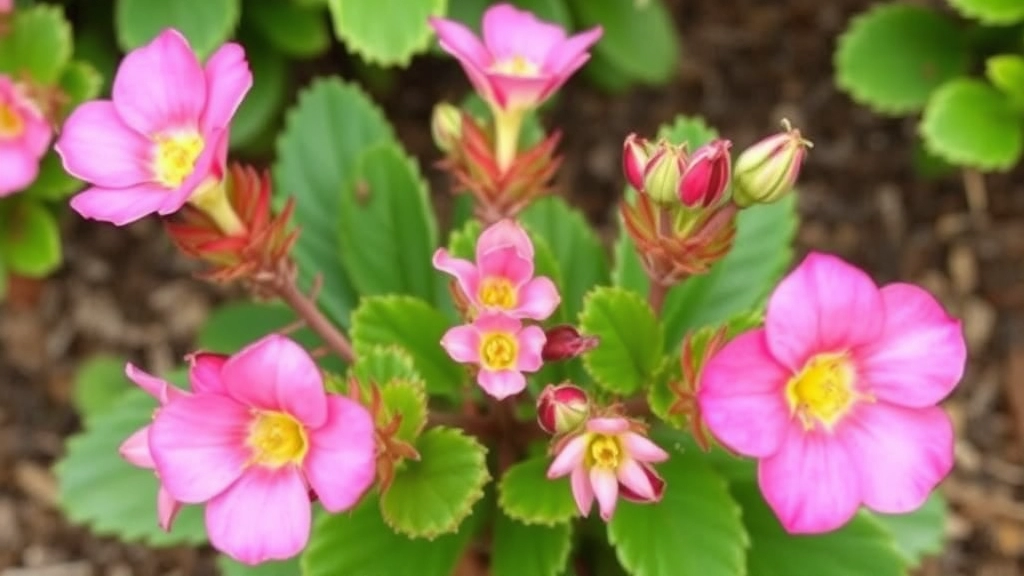Types of Kalanchoe Tomentosa
When it comes to the types of Kalanchoe Tomentosa, also known as the Panda Plant, there’s a fascinating variety to explore. These succulents are loved for their fuzzy, velvety leaves and come in several unique cultivars, each with its own charm. Whether you’re a seasoned gardener or a succulent newbie, understanding the different types can help you choose the perfect Panda Plant for your collection.
From the classic Kalanchoe Tomentosa with its silver-green leaves edged in brown to the more exotic varieties with smooth or differently coloured foliage, there’s something for everyone. Knowing the distinct features of each type not only enhances your appreciation but also guides you in providing the right care to keep your plants thriving.
When you’re on the hunt for the perfect Kalanchoe Tomentosa, you might wonder which varieties stand out and what makes each unique. Kalanchoe Tomentosa, often referred to as “Panda Plant,” is loved for its fuzzy leaves and striking appearance.
### 1. Kalanchoe Tomentosa ‘Fang’
– **Features**: This variety is known for its distinctive, elongated leaves that have pointed tips resembling fangs.
– **Appearance**: The leaves are covered in soft, fine hairs, giving them a fuzzy texture.
– **Growth Habit**: ‘Fang’ tends to grow upright, making it an eye-catching addition to any succulent collection.
### 2. Kalanchoe Tomentosa ‘Chocolate Soldier’
– **Features**: As the name suggests, this variety has a rich, chocolate-brown edge on its leaves.
– **Appearance**: The contrast between the green center and the brown edges creates a striking visual appeal.
– **Growth Habit**: It exhibits a bushy growth pattern, making it perfect for filling spaces in your garden or indoors.
### 3. Kalanchoe Tomentosa ‘Silver’
– **Features**: This variety is characterized by its silvery-grey leaves, which are also covered in soft hairs.
– **Appearance**: The silver hue adds a unique touch, making it stand out among other succulents.
– **Growth Habit**: ‘Silver’ can grow quite tall, often reaching heights of up to 30 cm.
### 4. Kalanchoe Tomentosa ‘Variegata’
– **Features**: This cultivar showcases a mix of green and creamy-white leaves, creating a beautiful contrast.
– **Appearance**: The variegated pattern makes it one of the most sought-after varieties.
– **Growth Habit**: It tends to grow more slowly than other varieties, but its unique appearance makes the wait worthwhile.
For more detailed information on how to care for these varieties, you can check out the [Kalanchoe Tomentosa Care Tips and Growing Guide](https://planthq.org/succulent-kalanchoe-tomentosa-care-tips-and-growing-guide/). Additionally, if you’re interested in propagation methods, the [Kalanchoe Tomentosa Propagation Guide](https://planthq.org/kalanchoe-tomentosa-propagation-guide-stepbystep-tips/) provides step-by-step tips.
Differences Between Fuzzy and Smooth-Leaf Varieties

When diving into the world of Kalanchoe Tomentosa, one of the first questions that pop up is: “What’s the difference between the fuzzy and smooth-leaf varieties?” It’s a great question and one that can really enhance your understanding of these charming plants.
Fuzzy-Leaf Varieties
Fuzzy-leaf Kalanchoe, often referred to as Kalanchoe tomentosa, boasts soft, velvety leaves that are covered in tiny hairs. These hairs give the leaves a unique texture, making them feel almost like a plush toy.
- Appearance: The leaves are typically grey-green with a slight silvery sheen.
- Care Needs: They thrive in bright, indirect light and prefer drier soil. Too much moisture can lead to root rot.
- Pest Resistance: The fuzziness can help deter some pests, but they’re not immune to issues like mealybugs.
Smooth-Leaf Varieties
On the flip side, the smooth-leaf varieties of Kalanchoe offer a completely different vibe. These leaves are sleek and shiny, making them stand out in any collection.
- Appearance: The leaves are usually a deeper green and can sometimes have a waxy finish.
- Care Needs: They enjoy similar light conditions but can handle a bit more moisture compared to their fuzzy counterparts.
- Pest Resistance: Their smooth surface can make them more susceptible to pests like aphids, so keep an eye out!
Key Differences at a Glance
| Feature | Fuzzy-Leaf Varieties | Smooth-Leaf Varieties |
|---|---|---|
| Texture | Soft and velvety | Sleek and shiny |
| Color | Grey-green with silvery sheen | Deep green, sometimes waxy |
| Water Needs | Prefers dry soil | Can tolerate slightly more moisture |
| Pest Resistance | More resistant to some pests | More susceptible to aphids |
How to Identify the Unique Cultivars of Kalanchoe Tomentosa
When it comes to Kalanchoe Tomentosa, distinguishing between its unique cultivars can be a delightful yet daunting task. Many enthusiasts wonder how to differentiate these varieties effectively.
Key Characteristics to Look For
- Leaf Texture:
- Fuzzy Varieties: These have a soft, velvety texture due to tiny hairs covering the leaves.
- Smooth Varieties: These feature a glossy surface, lacking the fuzzy appearance.
- Leaf Shape: Some cultivars display rounded leaves, while others have elongated or serrated edges. Noting these differences can help narrow down your options.
- Colour Variations: The leaf colour can range from vibrant green to silvery-grey, depending on the specific cultivar. Pay attention to subtle shades and patterns.
- Growth Habit: Observe whether the plant grows upright or has a more sprawling habit. This can provide clues about its specific type.
Practical Tips for Identification
- Compare with Images: Use reliable plant databases or social media plant groups to compare your plant with images of known cultivars. For a visual guide to identification, check out the Kalanchoe Pinnata Images Visual Guide.
- Join Plant Communities: Engage with fellow enthusiasts online or in local gardening clubs. Sharing photos and insights can lead to valuable identification help. Additionally, for step-by-step tips on propagation, you can refer to the Kalanchoe Tomentosa Propagation Guide.
- Consult Experts: Don’t hesitate to ask for guidance from local nurseries or botanical gardens. Their expertise can be invaluable.
Growth Patterns and Sizes of Kalanchoe Tomentosa Varieties

Understanding the growth patterns and sizes of Kalanchoe Tomentosa varieties is crucial for both new and seasoned plant enthusiasts.
Are you wondering how these charming succulents develop over time?
Kalanchoe Tomentosa, often known as the “Panda Plant,” showcases a variety of growth habits that can greatly influence its care and placement in your home.
Growth Patterns
- Fuzzy-Leaved Varieties: These tend to grow more compactly and can reach heights of about 30-45 cm. Their bushy appearance makes them ideal for small spaces.
- Smooth-Leaved Varieties: Typically, these can grow taller, reaching up to 60 cm. They have a more elongated growth pattern, which can create a striking visual effect in larger pots.
- Growth Rate: Generally, Kalanchoe Tomentosa varieties are slow to moderate growers. Expect noticeable growth during the warmer months, particularly in spring and summer.
Size Variations
- Small Varieties: Some cultivars may only reach about 15-20 cm in height, making them perfect for desk plants or terrariums.
- Medium Varieties: Most common types fall into this category, averaging between 30-45 cm. They can thrive in standard pots and can be easily managed indoors.
- Large Varieties: A few exceptional cultivars can grow up to 60 cm or more, making them suitable for statement pieces in your living room or garden.
When it comes to caring for your Kalanchoe Tomentosa, understanding the specific needs of each cultivar is essential. Different varieties may have unique characteristics that influence their care requirements.
### Light Requirements
– **Fuzzy Varieties**: Prefer bright, indirect sunlight. Too much direct sun can scorch their leaves.
– **Smooth-Leaf Varieties**: Thrive in full sun but can tolerate partial shade.
### Watering Guidelines
– **General Rule**: Allow the soil to dry out completely between waterings.
– **Fuzzy Varieties**: Tend to require less frequent watering. Water only when the top inch of soil feels dry.
– **Smooth-Leaf Varieties**: May need slightly more water but still follow the same drying rule.
### Soil Preferences
– **Well-Draining Soil**: Use a cactus or succulent mix to prevent root rot. For more detailed soil recommendations, you can refer to the [best soil for Kalanchoe Blossfeldiana care tips](https://planthq.org/best-soil-for-kalanchoe-blossfeldiana-care-tips/).
– **pH Level**: Aim for a slightly acidic to neutral pH (6.0 to 7.0).
### Fertilisation Tips
– **Growing Season**: Fertilize during spring and summer with a diluted, balanced fertiliser.
– **Fuzzy Varieties**: Less fertiliser is needed; a quarter-strength solution every month suffices.
– **Smooth-Leaf Varieties**: Can handle a bit more fertiliser, so consider half-strength every month.
### Temperature and Humidity
– **Ideal Range**: Kalanchoe Tomentosa prefers temperatures between 15°C to 27°C. To understand the optimal conditions better, check out the [ideal temperature for Kalanchoe Blossfeldiana growth](https://planthq.org/ideal-temperature-for-kalanchoe-blossfeldiana-growth/).
– **Humidity**: These plants thrive in low humidity, making them perfect for indoor settings.
### Pruning and Maintenance
– **Regular Pruning**: Helps maintain shape and encourages bushier growth.
– **Remove Dead Leaves**: This prevents pests and diseases from taking hold.
Common Pests and Diseases in Different Varieties of Kalanchoe Tomentosa

So, you’ve got your Kalanchoe Tomentosa thriving, but what happens when those pesky pests or diseases come knocking?
It’s a real concern for many plant lovers, and I get it. You want your fuzzy-leaved friend to stay healthy and happy.
Pests to Watch Out For
- Mealybugs:
- These little white cottony bugs love to hide in the leaf joints.
- They suck the sap, which can weaken your plant.
- Spider Mites:
- Tiny and often invisible, they create fine webs that can be a telltale sign.
- They thrive in dry conditions, so keep an eye out, especially in summer.
- Aphids:
- These small, green or black bugs can cluster on new growth.
- They also suck sap and can lead to distorted leaves.
Diseases to Be Aware Of
- Powdery Mildew:
- A white, powdery fungus that can appear when humidity is high.
- It can affect the plant’s ability to photosynthesize properly.
- Root Rot:
- Usually caused by overwatering, this disease can be a silent killer.
- Check for mushy roots if your plant starts to droop.
- Leaf Spot:
- Dark spots on leaves can indicate fungal infections.
- Keep the leaves dry to avoid this issue.
Prevention Tips
- Regular Inspection: Check your plants weekly for any signs of pests or diseases. Early detection is key!
- Good Airflow: Ensure your plant has enough space around it to breathe.
- Proper Watering: Avoid overwatering to keep root rot at bay.
When it comes to propagating Kalanchoe Tomentosa, understanding the nuances of different varieties can make a significant difference in your success. Whether you’re a seasoned gardener or just starting, knowing the best practices for propagation will ensure your plants thrive.
Common Propagation Methods
– **Leaf Cuttings**
– **Select a Healthy Leaf**: Choose a mature, healthy leaf from the parent plant.
– **Let it Callous**: Allow the cutting to dry for a few days to form a callous over the cut end.
– **Planting**: Place the leaf in well-draining soil, ensuring the cut end is buried slightly.
– **Water Sparingly**: Water the soil lightly, allowing it to dry out between waterings.
– **Stem Cuttings**
– **Choose a Stem**: Cut a healthy stem with several leaves attached.
– **Prepare the Cutting**: Remove the lower leaves to expose the stem.
– **Callous Formation**: Similar to leaf cuttings, let the cut end dry for a few days.
– **Planting**: Insert the stem into the soil, ensuring it’s stable.
– **Humidity**: Cover with a plastic bag for humidity, but remove it once roots develop.
– **Offsets**
– **Identify Offsets**: Look for small offsets or pups at the base of the parent plant.
– **Separation**: Gently twist or cut the offset from the parent.
– **Replanting**: Plant the offset in its own pot with the same soil mix.
– **Watering**: Water lightly until established.
Tips for Successful Propagation
– **Timing Matters**: The best time for propagation is during the growing season, typically spring and summer.
– **Soil Choice**: Use a cactus or succulent mix for optimal drainage.
– **Lighting Conditions**: Place cuttings in bright, indirect light to prevent scorching.
– **Patience is Key**: Roots may take several weeks to develop, so resist the urge to check too often.
Troubleshooting Common Issues
– **Rotting Cuttings**: If you notice mushy cuttings, it’s likely due to overwatering. Ensure the soil dries out completely between waterings.
– **Weak Growth**: Insufficient light can lead to leggy growth. Move your cuttings to a brighter spot.
For more detailed guidance, you can refer to the [Kalanchoe Tomentosa Propagation Guide](https://planthq.org/kalanchoe-tomentosa-propagation-guide-stepbystep-tips/) and explore various [Kalanchoe Tomentosa Varieties](https://planthq.org/kalanchoe-tomentosa-varieties-care-types-and-propagation/) to enhance your gardening skills.
FAQs About Types Of Kalanchoe Tomentosa
What are the main differences between fuzzy and smooth-leaf Kalanchoe Tomentosa varieties?
The primary differences lie in texture, appearance, and care needs. Fuzzy-leaf varieties have soft, velvety leaves covered in tiny hairs, while smooth-leaf varieties have sleek, shiny leaves. Fuzzy varieties prefer drier soil, whereas smooth varieties can tolerate slightly more moisture.
What are the growth patterns of Kalanchoe Tomentosa varieties?
Fuzzy-leaved varieties tend to grow more compactly, reaching heights of about 30-45 cm, while smooth-leaved varieties can grow taller, up to 60 cm. Both types generally have a slow to moderate growth rate, with noticeable growth during warmer months.
How do the sizes of different Kalanchoe Tomentosa varieties compare?
Sizes vary from small varieties (15-20 cm) suitable for desks or terrariums to medium varieties (30-45 cm) ideal for standard pots, and large varieties (up to 60 cm) which can serve as statement pieces in living rooms or gardens.
What pests commonly affect Kalanchoe Tomentosa?
Common pests include mealybugs, spider mites, and aphids. Mealybugs hide in leaf joints and suck sap, spider mites create fine webs and thrive in dry conditions, and aphids cluster on new growth, also sucking sap and causing leaf distortion.
What diseases should I be aware of in Kalanchoe Tomentosa?
Diseases to watch out for include powdery mildew, root rot, and leaf spot. Powdery mildew appears as a white fungus in high humidity, root rot is caused by overwatering, and leaf spot manifests as dark spots from fungal infections.
How can I prevent pests and diseases in my Kalanchoe Tomentosa?
Prevention tips include regular inspection for early detection, ensuring good airflow around the plant, and proper watering practices to avoid overwatering and root rot.
References
-
How to Grow and Care for Kalanchoe Tomentosa (Panda Plant)
-
Kalanchoe Tomentosa Care: Growing Panda Plants
-
Kalanchoe tomentosa (Panda Plant)
